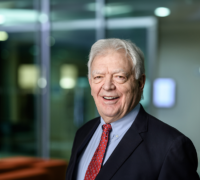
Why leaders should learn to value the boundary spanners
Entrepreneurial talent who work with other teams often run into trouble with their managers. Here are ways to get the most out of your ‘boundary spanners’...
Audio available

by George Kohlrieser Published October 20, 2023 in Leadership • 7 min read •

Before the pandemic, Jane was a well-respected CFO at a pharmaceutical company who drove an hour each way to the office. When the COVID-19 crisis hit, Jane – like millions of others – was forced to work from home. A silver lining was the extra time she had to spend with her grandchildren. As restrictions eased, however, the CEO wanted her back in the building full-time. She had forgotten how many hours the daily commute consumed and tried to negotiate for a couple of days a week at home. But he refused. So she quit. He was shocked.
What the CEO had failed to realize is that the pandemic has heralded a permanent shift in the way people want to be led. While several high-profile executives – among them Elon Musk, the Tesla CEO and owner of X (formerly Twitter) – have tried to revive an authoritarian style of leadership, this is unlikely to lead to results in the long term. Employees have become accustomed to a more compassionate and empathetic workplace. They want to be treated as people, not just workers, and those who don’t feel bonded to their team, or a sense of purpose, are more likely to cut ties.
Drawing on my experience of working with hundreds of executives across different sectors, here are seven ways in which the art of leadership has evolved as a result of the pandemic – changes that I believe leaders should adopt as permanent traits, if they have not done so already:
While the hierarchical “command and control” management model where leaders made decisions and issued orders was already dead long before COVID, the pandemic well and truly hammered the nails into the coffin. This was the case for a restaurant chain with over 4,000 franchises across the US. Prior to the pandemic, top management dictated everything – right down to how often the toilets should be cleaned in individual restaurants. Employees felt they were treated like children, morale was low, and business was in decline. When COVID hit, the situation worsened. To avoid bankruptcy, they hired a new CEO who implemented a different strategy – to give back power to the managers. Emboldened to make changes to the menu and introduce special offers based on their knowledge of the local area, managers achieved a turnaround within six months. In today’s uncertain economic environment, collaborative leadership that fosters innovation, creativity, and engagement, will ultimately lead to better results.
Musk may think it’s fine to issue demands with an iron fist, but people are fed up with being told what to do and view their work as solely transactional. This has led to a collapse in the traditional hierarchy between manager and employee. Instead, leadership is now viewed as a dynamic relationship between leaders and their followers. A great leader will build strong relationships based on trust, mutual respect, and effective communication to work with and influence others. They actively listen to their teams, solicit feedback, and create an inclusive environment where everyone feels valued and heard.

No organization can escape the need to transform to become more sustainable. The need to act is urgent. It calls for strong leadership, difficult decisions, and deep cultural change. In Issue XI, we explore how to build sustainable organizations to succeed in turbulent times.
We often hear the phrase “the customer comes first.” Today’s leaders will recognize that the success of their organization depends on understanding and meeting the needs of both customers and employees. After all, if you have happier employees who find meaning and purpose in their roles, they are more likely to deliver exceptional customer experience. This involves ensuring your teams have the necessary support, resources, and development opportunities to thrive and do their best work. One leader who exemplifies this trait is Jørgen Vig Knudstorp, Member of the Board at LEGO A/S and Executive Chairman of LEGO Brand Group, who led the turnaround of the children’s play materials group when he was CEO. Knudstorp advocated a leadership style of “serious play” where he gave his leadership team huge amounts of autonomy and asked them to surprise him rather than just doing what they were told. He understood that to make the customer happy, the employee must come first.
The upheaval and grief caused by the pandemic triggered a great deal of reflection among today’s workers about how they spend their time. People want to feel they are both valued and creating value in their roles. Yet just 45% of people responding to a Gartner survey believed their organization saw them as a person. To overcome this, leaders should shift their focus simply from achieving goals to leading with meaning and purpose. By connecting the work of their teams to a larger vision and articulating a compelling purpose that resonates with the values of employees, they will increase motivation and employee retention.
The pandemic put the mental health of millions under pressure and many people are still grieving, either for lost loved ones or lost opportunities. This has led to a state of heightened emotions that calls for leaders who can consider people’s feelings, and how this affects their behavior. At one financial firm, a manager started to worry about his star performer, who seemed increasingly disengaged, leading to a drop in the quality of his work. The manager called a one-to-one meeting to discuss the problem. The employee admitted he was grieving for his mother who had died during COVID when he was unable to be with her to say goodbye. By being emotionally available and sensitive to the situation, the manager allowed the employee to gradually process his grief and return to the top of his game.

People want to feel they are both valued and creating value in their roles. Yet just 45% of people responding to a Gartner survey believed their organization saw them as a person.
Psychological safety, a concept popularized by Harvard leadership scholar Amy Edmondson, has gained recognition as an essential element in effective leadership, and one that is increasingly valued by workers. A 2023 Work in America Survey by the American Psychological Association found that 92% of workers said it was very (57%) or somewhat (35%) important to work for an organization that values their emotional and psychological well-being. Leaders who prioritize psychological safety foster an environment where individuals feel comfortable taking risks, speaking up, and expressing their opinions without fear of negative consequences. One such leader is Jakob Stausholm, CEO of Rio Tinto, who, along with the executive committee, is building a culture at the mining group where employees are encouraged to say the truth with respect and put the “fish on the table” – an expression that means raising a difficult issue openly and dealing with important differences.
In the past, we might have viewed leadership as a performance – you had to look the part and speak a certain way. Today, as we increasingly value diverse perspectives, leadership is no longer confined to a set of prescribed behaviors; it is a deeply personal expression of one’s values, experiences, and aspirations. Leaders must embrace their unique leadership stories, sharing their authentic selves and inspiring others through their narratives. By embracing their individuality and vulnerability, leaders can establish genuine connections, inspire trust, and cultivate a culture of authenticity within their organizations.
It may be tempting for leaders, especially those facing hard economic times, to advocate a tougher and more emotionless style of leadership. My response is that being a collaborative, purpose-driven, and emotionally intelligent leader doesn’t mean you coddle and rescue people. There are times when you will have to give tough feedback, and maybe even fire staff. The difference is that you can do this in a way that is both respectful and kind, where you treat employees as people and not just disposable objects. By embracing the value of building relationships, fostering psychological safety, and leveraging emotions to motivate teams, leaders will be able to adapt to the dynamic needs of organizations, inspiring employees to take the risks needed to drive sustainable growth in the face of ever-evolving challenges.

Distinguished Professor of Leadership and Organizational Behaviour at IMD
Professor of Leadership and Organizational Behavior at IMD and Director of the High Performance Leadership program, the Advanced High Performance Leadership program, and the Inspirational Leadership program. He serves as a consultant to several global companies including Accenture, Amer Sports, Borealis, Cisco, Coca-Cola, HP, Hitachi, IBM, IFC, Jaeger-LeCoultre, Morgan Stanley, Motorola, NASA, Navis, Nestlé, Nokia, Pictet, Rio Tinto, Roche, Santander, Swarovski, Sara Lee, Tetra Pak, Toyota, and UBS.

July 3, 2025 • by Eric Quintane in Audio articles
Entrepreneurial talent who work with other teams often run into trouble with their managers. Here are ways to get the most out of your ‘boundary spanners’...
 Audio available
Audio available
June 24, 2025 • by Jerry Davis in Audio articles
The tech broligarchs have invested heavily in Donald Trump but are not getting the payback they bargained for. Do big business and the markets still shape US government policy, or is the...
 Audio available
Audio available
June 19, 2025 • by David Bach, Richard Baldwin, Simon J. Evenett in Audio articles
As governments lock horns in our increasingly multipolar world, long-held assumptions are being upended. Forward-looking executives realize the next phase of globalization necessitates novel approaches....
 Audio available
Audio available
June 2, 2025 • by George Kohlrieser in Audio articles
Leadership Honesty and courage: building on the cornerstones of trust by George Kohlrieser Published 17 April 2025 in Leadership • 5 min read DownloadSave Trust is the bedrock of effective leadership. It...
 Audio available
Audio availableExplore first person business intelligence from top minds curated for a global executive audience